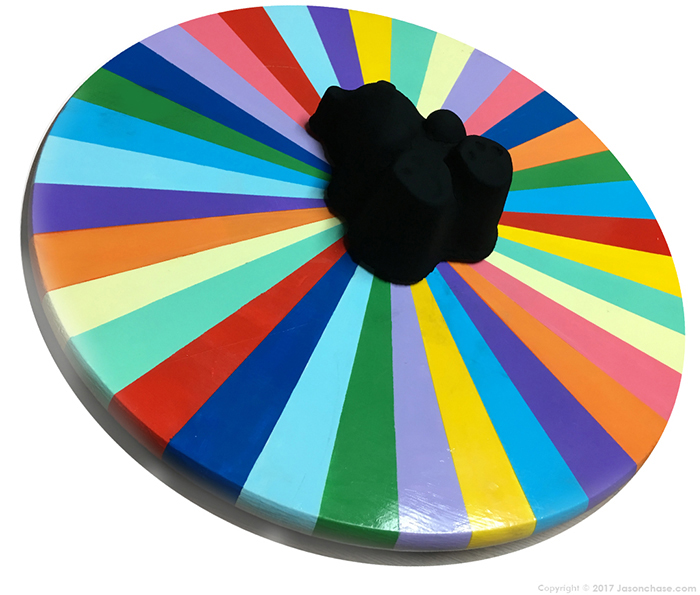Color is our perception of reflected light across the visible spectrum. When light hits an object, it absorbs some rays and reflect others. The color of light that reflects back into our eyes is the color we perceive. The more light an object absorbs, the darker it appears. With black, very little light is reflected.
Pure black in the presence of light wasn’t achieved until 2014 when Surrey NanoSystems announced the invention of Vantablack. This high-tech artificial substance absorbs 99.965% of all light that hits it, from the ultraviolet, through the visible and well into the infrared spectrum. When applied to an object, Vantablack makes the object look like a flat, bottomless void in space.
Here you see a crumpled piece of aluminum foil, with Vantablack covering the middle. There is so little reflection you can’t even perceive the wrinkled texture!

Image Copyright Surrey NanoSystems 2017
In 2016, NanoSystems announced an even darker black – Vantablack 2. It absorbs so much light that their spectrophotometers can’t even measure it!

Image Copyright Surrey NanoSystems 2017
You can’t find Vantablack at your local hardware store. Achieving this blacker-than-black appearance requires intensive processing at the company’s UK facility. It’s currently used in applications like high-performance infrared cameras, sensors, scientific instruments, satellite-borne calibration sources, and in certain high-end luxury products like this limited edition Sequential One S110 Evo Vantablack Watch.
But don’t give up hope! Not long after the launch of Vantablack, Waltham, Massachusetts, firm NanoLab, Inc. (under contract to NASA) brought ultimate black to the rest of the world. SINGULARITYTM Black is a solvent-based paint that can be air brushed in a spray booth using protective masks, dipped, or brush coated. While it’s not quite as black as Vantablack, it’s pretty impressive.

The original Black Iron Ursa created by Jason Chase is the world’s first piece of art using Singularity Black paint. Image Copyright Jason Chase 2017
What Does This Mean for Manufacturers Who Produce Black?
The ability to trick the human eye with the color black presents endless opportunities for product design and marketing. But, as manufacturers know, even “normal” black can be quite a challenge to control. Color management for black seems a little counterintuitive. In reality, to achieve the blackest black, and ensure it matches across assembled parts, color management for black is even more important than ever.
Here are five tips for controlling this color (or lack thereof):
1 – Don’t Just Rely on Spectrophotometry
Spectrophotometers work by measuring the amount of reflection at each wavelength of the visible spectrum. Since black has very little reflection on the visible spectrum, it can be difficult for a spectrophotometer to identify color difference. Which leads us to tip #2…
2 – Incorporate Visual Evaluation

Judge QC
Even if your spectro tells you your colors are in tolerance, you could still send unsatisfactory parts if they don’t look right after they’re assembled. At some point during production, someone must visually evaluate these parts – next to each other and under different controlled light sources – to make sure they are ready to ship. The SpectraLight QC and Judge QC are our two most popular light booth solutions for the job.
3 – Use the Same Illuminant
If you set D65 as the illuminant in your device but visually evaluate under fluorescent light, you’re not going to get the same reflection. It’s very important to coordinate your visual viewing conditions with what the instrument is measuring.
4 – Pair Tolerances with Common Sense
Tolerances provide guidance on how much color difference (Delta E) is acceptable. While humans can usually notice a difference around 1 Delta E, the acceptable Delta E varies by industry and application. Download this free tolerancing guide to learn more.
When working with black, manufacturers need to closely control the Delta E to ensure a good production match, but even that is not enough. Sometimes a spike in Delta E doesn’t mean the color is wrong if there’s not much reflected light. As I said above, always pair spectral data with a common sense visual evaluation process.
5 – Watch for Metamerism
When dealing with overly saturated colors, you have to monitor metamerism – a phenomenon that occurs when two colors appear to match under one lighting condition, but not when the light changes. Check out this popular blog by Tim Mouw to learn more.
We’re Up For The Challenge!
If controlling black is important to your business but you are still having issues, our color experts are here to help.
